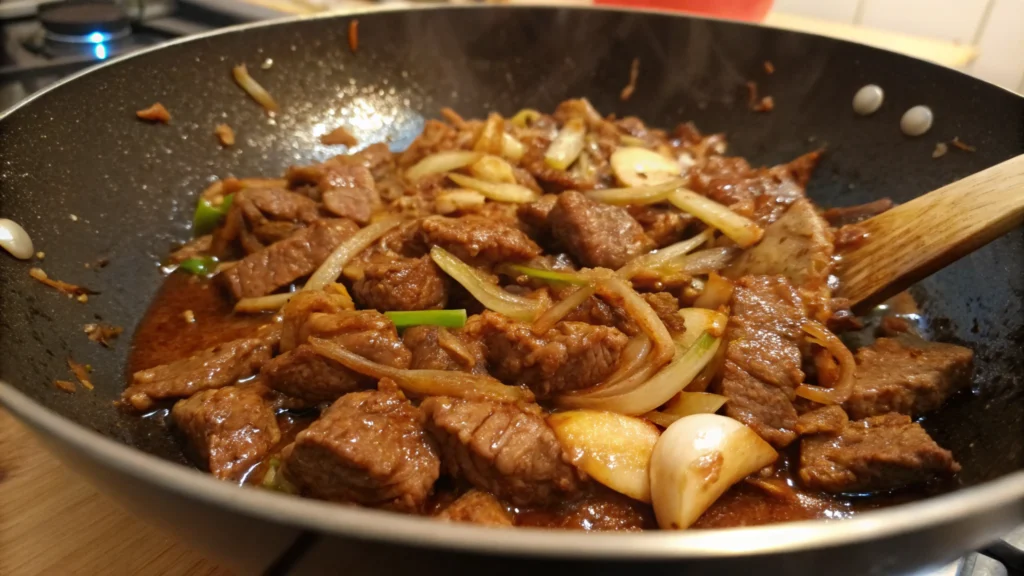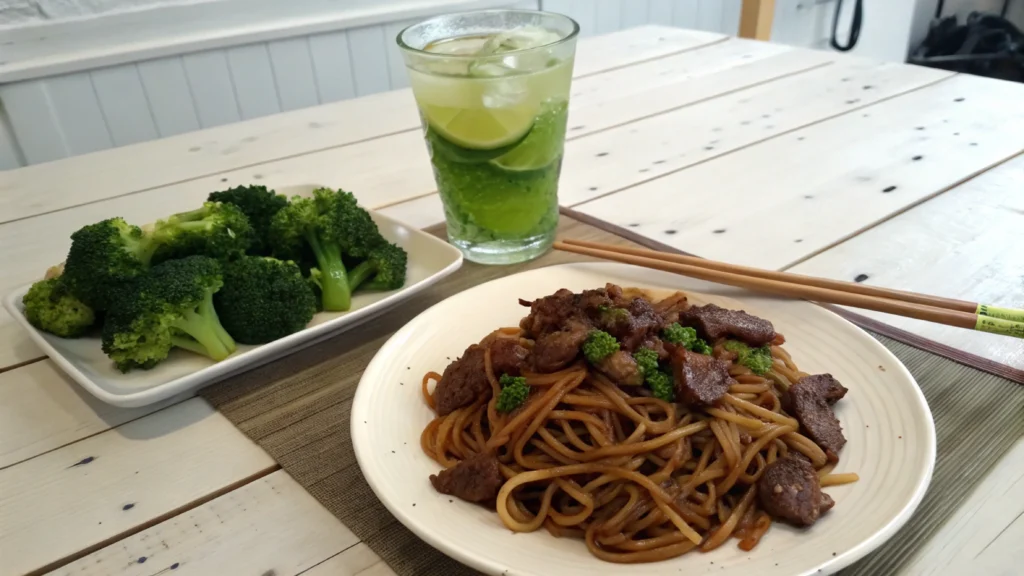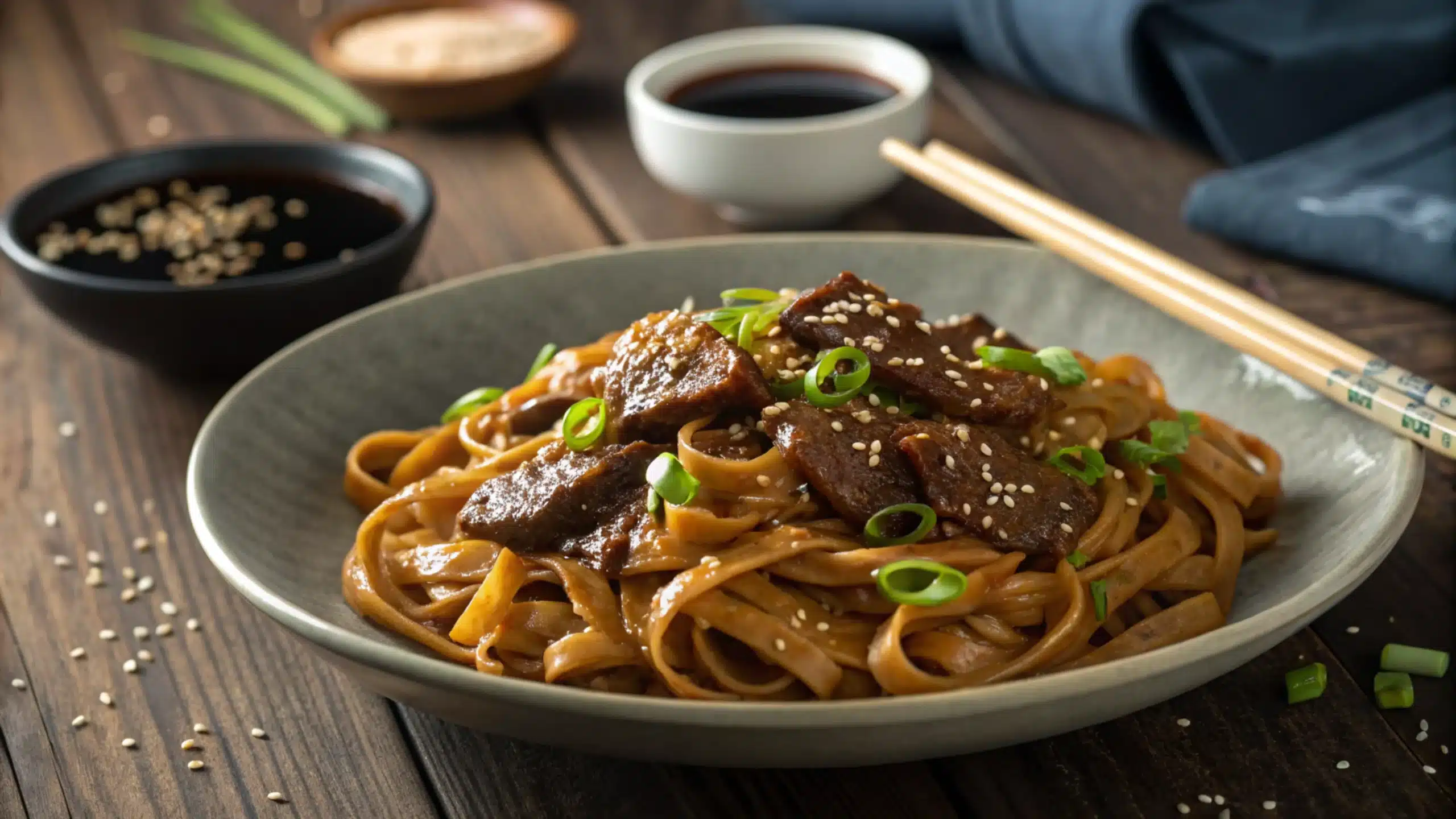Mongolian Beef Noodles are a satisfying culinary advent that mixes the bold flavors of Mongolian beef with the consolation of soft noodles. This dish is an ideal blend of candy, savory, and a hint of spice, making it a fave among meal fans. In this text, we will dive into the whole lot you need to know about getting ready, customizing, and serving Mongolian pork noodles. From expertise in its origins to crafting the suitable plate, we have got you included. Let’s start with an exploration of its wealthy background and attraction.
The Origins of Mongolian Beef and Its Culinary Journey
While Mongolian beef does not hail from Mongolia itself, its origins lie in Chinese-American cuisine. This iconic dish showcases soft beef cooked in a sweet and savory sauce flavored with soy, garlic, and ginger. When paired with noodles, it transforms right into a heartwarming meal that bridges the space between culture and modern comfort meals.
The fusion of Mongolian red meat with noodles is a nod to the growing international appreciation for Asian-stimulated dishes. With its roots in Chinese stir-fry techniques and American culinary twists, this dish has emerged as a staple in families and eating places worldwide.
The Growing Popularity of Noodles in Asian-Inspired Dishes
Noodles are a cornerstone of Asian cuisine, symbolizing sturdiness and prosperity in lots of cultures. In dishes like Mongolian beef noodles, they act as a super canvas to take in the wealthy, flavorful sauces. From lo mein to rice noodles, this factor brings a chewy texture that enhances the soft pork and fragrant sauce.
Why Mongolian Beef Noodles Are a Crowd-Pleaser
This dish hits all the right notes. The candy soy sauce stir-fry stabilizes the flavors, while the beef and noodles provide substance and texture. It’s flexible, customizable, and short to prepare—characteristics that make it a go-to for busy weeknights or informal gatherings.
Key Ingredients and Their Roles
Beef Varieties: Flank, Sirloin, or Ground Beef?
The star of Mongolian pork noodles is the beef itself. Choosing the proper reduction can increase the dish to a new degree. Flank steak is a famous desire because of its tenderness and ability to absorb marinades. Sirloin steak is another brilliant choice, supplying a balance of tenderness and taste. For a budget-pleasant twist, floor red meat can also be used, as proven in this ground beef bulgogi recipe. Regardless of the cut, cutting thinly and in opposition to the grain ensures a melt-in-your-mouth texture.
The Signature Mongolian Sauce: Sweet, Savory, and Spicy
A great sweet soy sauce stir-fry starts offevolved with a suitable mixture of flavors. The conventional Mongolian sauce is a harmony of soy sauce, hoisin, brown sugar, and a hint of vinegar for tanginess. Garlic and ginger lend intensity, at the same time as purple pepper flakes, adding a hint of heat. This sauce is what makes Mongolian pork noodles impossible to resist.
Noodles: The Backbone of the Dish
Choosing the right noodles is just as important as selecting the pork. Lo mein or egg noodles are ideal because they absorb the sauce without becoming smooth. For a gluten-unfastened opportunity, rice noodles work beautifully. The noodles act as a vessel, handing over the savory soy and hoisin sauce in every bite.
Enhancements: Garlic, Ginger, and Vegetables
Garlic and ginger form the dynamic duo that forms the aromatic base of this dish. Vegetables like bell peppers, carrots, and snap peas add color, crunch, and a dietary boost. These components not only enhance the dish’s flavor profile but also make it a well-rounded meal.
Step-through-Step Recipe for Perfect Mongolian Beef Noodles
Preparation: Setting Up for Success
Before you begin cooking, collect all of your elements. Slice the pork thinly and coat it lightly with cornstarch. Cook the noodles according to the package instructions, tossing them with sesame oil to prevent them from sticking.
Cooking the Beef: Achieving Tender and Flavorful Results
Heat a skillet or wok over medium-excessive heat and add a touch of oil. Sear the beef in small batches to ensure even cooking. Cook until browned, then set apart. This step locks in the juices, retaining the red meat soft.

Making the Sauce: Balancing the Flavors
In the same skillet, sauté garlic and ginger until fragrant. Add soy sauce, hoisin, brown sugar, and a touch of vinegar. Stir properly and allow the sauce to simmer until barely thickened. For a further kick, sprinkle in some pink chili flakes.
Assembling the Dish: Combining Noodles, Beef, and Sauce
Return the red meat to the skillet and coat it in the sauce. Toss in the cooked noodles and blend until everything is nicely mixed. Allow the noodles to soak up the sauce for a minute or earlier before serving.
Variations and Customizations
Gluten-Free Options: Adjusting the Ingredients
If you’re gluten-intolerant or prefer a gluten-unfastened meal, don’t worry! You can nevertheless enjoy Mongolian red meat noodles with a few tweaks. Replace conventional soy sauce with tamari or coconut aminos, which might be gluten-unfastened options. Use rice noodles rather than wheat-primarily based noodles like lo mein or spaghetti. These changes keep the dish’s scrumptious taste even as accommodating nutritional needs.
Spicy or Sweet? Tailoring the Sauce to Your Taste
One of the pleasant things about this dish is its adaptability. Love heat? Add more pink chili flakes, Sriracha, or even a spray of chili oil. Prefer it sweeter? Increase the brown sugar or drizzle in honey. Adjusting the sauce elements helps you to create a dish that completely matches your taste preferences.
Vegetarian Alternatives: Tofu or Mushrooms
For a vegetarian take on Mongolian beef noodles, swap the beef for tofu or hearty mushrooms like shiitake or portobello. Press the tofu to remove excess moisture, then marinate and cook it until crispy. Mushrooms may be sliced and stir-fried to provide a meaty texture that pairs fantastically with the sauce and noodles.
Serving Suggestions and Pairings
What to Serve with Mongolian Beef Noodles
Sweet soy sauce stir-fry dishes like Mongolian pork noodles are fairly versatile. Pair them with steamed rice for additional substance or a facet of stir-fried greens to boost vitamins. A light cucumber salad with a tangy dressing complements the rich flavors of the dish, imparting stability and variety.

Beverage Pairings: From Tea to Cocktails
Enhance your meal with the proper drink. For a conventional touch, serve warm, inexperienced tea or jasmine tea to cleanse the palate. If you’re seeking out something extra festive, a ginger-primarily based cocktail or a crisp lager pair wonderfully with the bold flavors of Mongolian beef noodles.
Plating Tips for a Restaurant-Style Presentation
Presentation topics! Serve your noodles in a shallow bowl, topping them with a sprinkle of sesame seeds and sliced green onions. A slice of lime at the side provides a pop of shade and a hint of acidity. These small touches make your homemade dish feel like an excellent eating experience.
For greater scrumptious recipes, check out this guide to dishes made with beef, which gives ideas on how to amplify your culinary repertoire!
FAQs About Mongolian Beef Noodles
What Do You Serve with Mongolian Beef?
A remarkable aspect of Mongolian pork noodles is how versatile they are. Pair them with steamed jasmine rice for a traditional touch or a side of stir-fried veggies like bok choy or broccoli to add a nutritious crunch. Want something lighter? A fresh cucumber or Asian-style slaw offers a refreshing contrast to the dish’s formidable flavors.
What Meat Goes Best with Ramen Noodles?
While Mongolian pork noodles commonly use red meat, other meats like hen, red meat, or shrimp can be tremendous substitutes when paired with ramen noodles. These proteins adapt superbly to the sweet and savory sauce, making the dish truly pleasant and flavorful.
What Does Mongolian Beef Consist Of?
Classic Mongolian beef consists of thinly sliced beef, soy sauce, hoisin, brown sugar, and aromatics like garlic and ginger. It’s cooked quickly at high heat for a gentle, caramelized end. When combined with noodles, this dish evolves into a hearty and comforting meal.
What is the Difference Between Mongolian Beef and Beijing Beef?
Though both dishes are rooted in Chinese-stimulated delicacies, their flavors differ. Mongolian red meat is savory and slightly sweet, relying on soy sauce and ginger for its signature taste. Beijing pork, on the other hand, is commonly sweeter and tangier, frequently offering crispy beef coated in a sticky sauce.
Final Thoughts
Revisiting the Allure of Mongolian Beef Noodles
Mongolian pork noodles are a testament to the magic of simple, terrific components. With smooth pork, chewy noodles, and a sauce that is sweet, savory, and just a little highly spiced, this dish has something for everybody. Whether you’re looking to impress guests or whip up a short weeknight meal, it’s a recipe worth maintaining for your rotation.
Encouraging Culinary Exploration at Home
The beauty of cooking lies in experimentation. With this manual, you could, create Mongolian beef noodles at home, tweaking the flavors to fit your preferences. Don’t be afraid to try versions like swapping proteins, including greater warmth, or making it gluten-free. The opportunities are limitless, and the result is constantly delicious.
For more thoughts and ideas, discover different beef-based dishes or noodle recipes to extend your culinary capabilities. Dive into the kitchen and let the rich, pleasant flavors of Mongolian pork noodles inspire your next meal!
Creative Twists on Mongolian Beef Noodles
Fusion Flavors: Combining Global Cuisines
Why now not supply your Mongolian pork noodles with a worldwide twist? Add a dollop of Thai purple curry paste to the sauce for a spicy kick, or sprinkle in Italian herbs like basil and oregano for a unique fusion experience. You can even blend in kimchi for a tangy Korean-stimulated variant.
Healthy Substitutions for a Guilt-Free Meal
You can transform this dish into a more fit option by swapping conventional noodles for zucchini noodles or spaghetti squash. Leaner proteins like turkey or chicken can also lighten the meal without sacrificing flavor.
Toppings That Elevate the Dish
Take your Mongolian beef noodles to the next stage with creative toppings. Try crispy fried onions, beaten peanuts, or sparkling cilantro for added texture and taste. A squeeze of lime or drizzle of sesame oil just before serving can also add a burst of freshness.
Advanced Cooking Tips for Perfect Results
Mastering the Sauce: Thickening and Balancing
Getting the sauce consistency right is crucial for a suitable plate of Mongolian beef noodles. Mix cornstarch with cold water to make a slurry before adding it to the sauce. This prevents lumps and guarantees a clean texture. Adjust the beauty, saltiness, and acidity to your desire to stabilize the flavors as you pass.
Perfecting the Beef: Tender and Juicy Every Time
For always smooth pork, freeze the beef for about 15 minutes earlier than cutting it thinly towards the grain. To similarly tenderize the slices, marinate them in soy sauce or a combination of baking soda and water for half an hour.
Achieving the Ideal Noodle Texture
To avoid overcooking your noodles, cook them for 1-2 minutes less than the package instructions. They will end cooking as you toss them in the sauce, ensuring they remain firm and flavorful. Tossing them in sesame oil after cooking prevents clumping and adds a nutty aroma.


5 thoughts on “Mongolian Beef Noodles: A Flavorful Fusion of Taste and Simplicity”